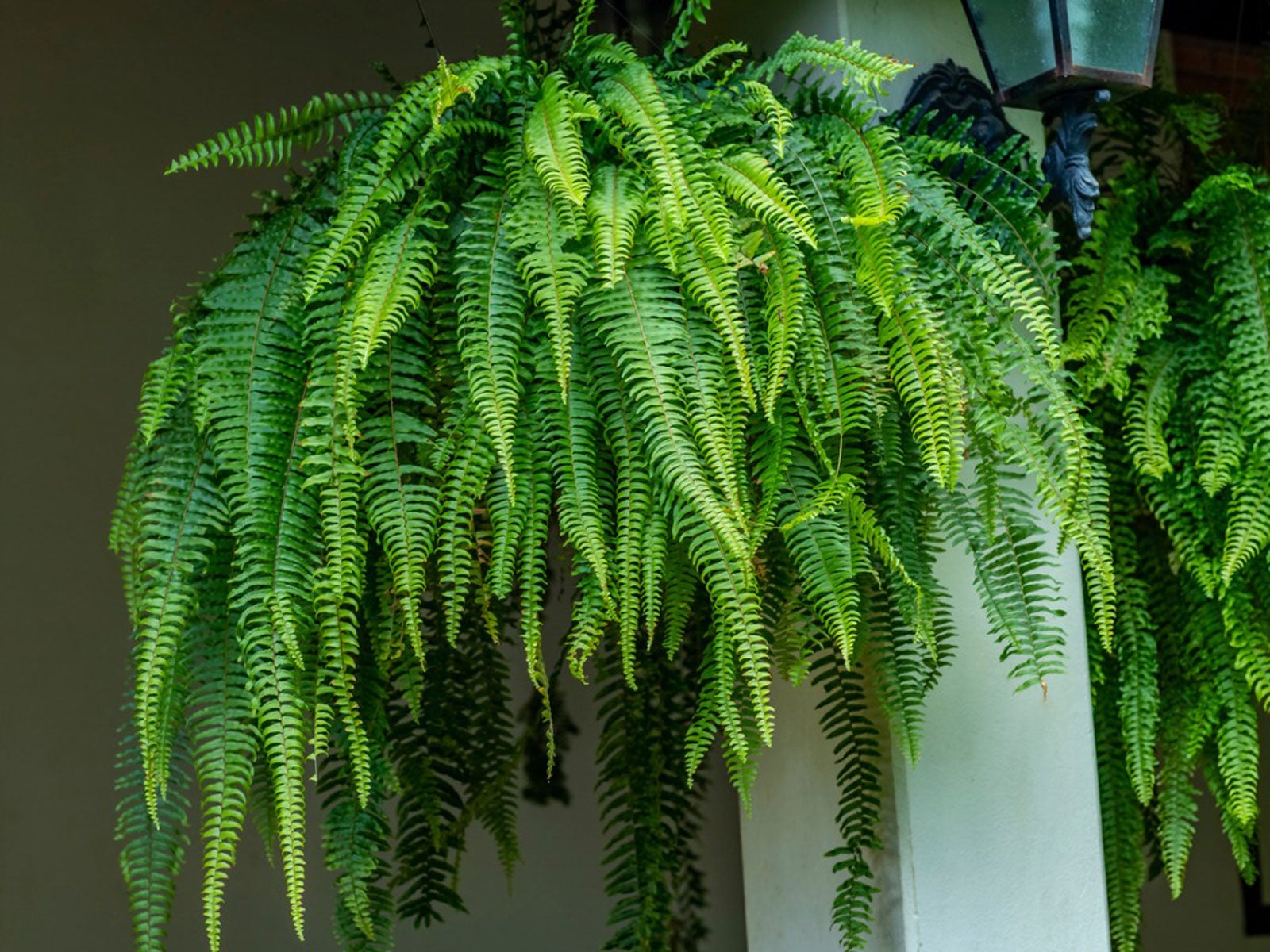Fern In A Hanging Container: Care Of Ferns In Hanging Baskets


Ferns have been a popular indoor plant for decades and ferns in hanging baskets are especially charming. You can also grow ferns in hanging containers outdoors; just be sure to bring them inside before temperatures drop in autumn. Check out the following tips for growing hanging ferns.
Where Do Hanging Ferns Grow Best?
Growing conditions may vary somewhat depending on the type of fern; however, most ferns don’t appreciate intense sunlight. Outdoors, a fern in a hanging container will generally do well with morning sunlight but needs afternoon shade.
Indoor ferns in hanging baskets usually do best in bright, indirect light such as a spot a few feet (1 m.) from a sunny window. Ideal temperatures are between 60 and 70 degrees F. (15-21 C.).
Most ferns appreciate humidity, and the bathroom is an ideal spot for ferns in hanging baskets. Otherwise, increase the humidity in your home with a humidifier or spritz the plant with a fine mist from time to time. Be sure your fern isn’t located too near a drafty door or window, air conditioner, or heating vent.
Tips on Hanging Fern Care
Plant your fern in a container that has a drainage hole in the bottom. Most hanging baskets have some type of drainage to ensure the roots don’t become waterlogged. Fill the container with a peat-based potting mix.
Moisture requirements depend on the type of fern. Some like the potting mix evenly moist, while others do better if the mix dries out slightly before watering. Either way, ensure the soil never becomes bone dry. Ferns in hanging baskets tend to dry out quickly and require more frequent watering, especially during the summer months. Be careful not to overwater during the winter.
Feed a fern in a hanging container every month during spring and summer using a balanced, water-soluble fertilizer mixed to half strength. Never apply fertilizer to dry soil.
Gardening tips, videos, info and more delivered right to your inbox!
Sign up for the Gardening Know How newsletter today and receive a free copy of our e-book "How to Grow Delicious Tomatoes".
Move the fern to a slightly larger container when the plant gets rootbound, usually every couple of years. Your fern may be rootbound if growth appears stunted, the potting mix dries out faster than usual, or water runs straight through the pot. You may also notice roots on the surface of the potting mix or poking through the drainage hole.

A Credentialed Garden Writer, Mary H. Dyer was with Gardening Know How in the very beginning, publishing articles as early as 2007.
-
 Looking For Plants To Give You The Soft And Fuzzies? Try These 5 Fuzzy Leaf Plant Options
Looking For Plants To Give You The Soft And Fuzzies? Try These 5 Fuzzy Leaf Plant OptionsLovers of texture, drama, silver foliage and tactile plants will adore these special sensory garden additions. These fuzzy leaf plant options will leave you all aglow
By Susan Albert
-
 Get Ready For A Summer Of Hummers! Grow These Full Sun Hummingbird Plants and Flowers
Get Ready For A Summer Of Hummers! Grow These Full Sun Hummingbird Plants and FlowersIf you’re lucky enough to enjoy a sunny backyard, make sure you are maxing out on your pollinator opportunities and grow these full sun hummingbird plants and flowers
By Tonya Barnett
-
 Polypodium Care: How To Grow And Care For Polypodium Ferns
Polypodium Care: How To Grow And Care For Polypodium FernsA small fern with a funny name, the polypodium - or polypody fern - likes to be shaded by trees and enjoys a moist environment.
By Bonnie L. Grant
-
 Southern Maidenhair Fern: Complete Care And Growing Guide
Southern Maidenhair Fern: Complete Care And Growing GuideThe delicate adiantum capillus-veneris, or maidenhair fern is a great addition to a woodland garden or indoor plant collection.
By Susan Albert
-
 Hardy Ferns For A Green Garden All Year Long
Hardy Ferns For A Green Garden All Year LongFerns are always a beautiful addition to your landscape. Learn which ones can take the cold weather and still stay green.
By Mary Ellen Ellis
-
 How To Care For A Tropical Mother Fern Indoors
How To Care For A Tropical Mother Fern IndoorsMother fern is a fern native to New Zealand sold as a common indoor houseplant. Click the following for information on mother fern indoor care and propagation.
By Amy Grant
-
 Growing Ferns As Houseplants: 9 Types Of Ferns To Grow Indoors
Growing Ferns As Houseplants: 9 Types Of Ferns To Grow IndoorsFern houseplants can add a tropical feel to an indoor space. Click here for nine beautiful varieties of fern well-suited to indoor growing.
By Mary Ellen Ellis
-
 Shield Fern Plant Info – Growing Southern Shield Ferns In Gardens
Shield Fern Plant Info – Growing Southern Shield Ferns In GardensFor a shade loving and deer resistant plant, try growing Southern Shield ferns. Click here for more information on this fern variety.
By Amy Grant
-
 Common Fern Varieties: Learn About Different Ferns To Grow
Common Fern Varieties: Learn About Different Ferns To GrowIf you’re searching for an unusual type plant to use in mostly shaded areas, consider the graceful textures and forms of fern varieties. Take advantage of various types of fern plants to grace the wooded landscape. Click here for some suggestions.
By Becca Badgett
-
 New York Fern Plants – How To Grow New York Ferns In Gardens
New York Fern Plants – How To Grow New York Ferns In GardensNew York fern, Thelypteris noveboracensis, is a woodland perennial that is native to and found throughout the eastern U.S. Learn more about the fern in this article and consider putting this native plant in your woodland garden or natural wetlands garden.
By Mary Ellen Ellis